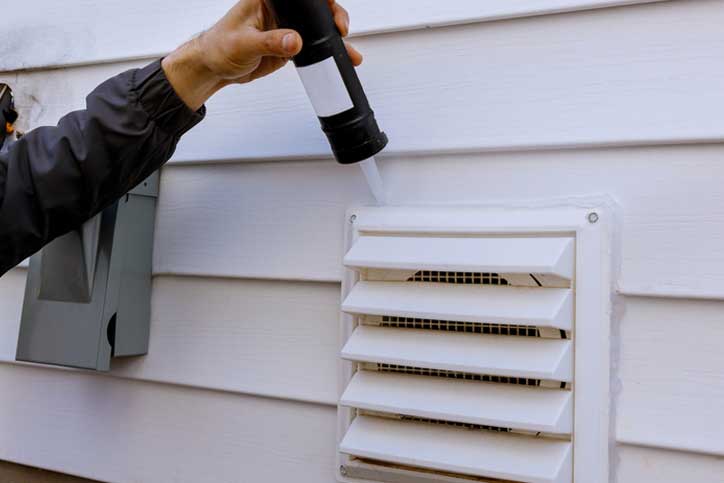Weatherproof your home and business for winter
The warm weather we’re experiencing right now is a welcome surprise, but as every Canadian knows, it won’t last long. Winter is on its way… and with it all the hazards of the season. Now is a great time to get your home or business ready for the coming ice, snow and wind while it’s still easy to do.
Stow away your tools
Tools and outdoor furniture can become damaged if exposed to outdoor temperatures for a lengthy period of time. Make sure to:
- store valuable outdoor items in your shed, garage, or basement;
- move furniture away from wind and snow, and cover any less weather-resistant pieces with a tarp; and
- disconnect any outside hoses from your buildings and stow them away properly.
Insulate your windows and doors
Both windows and doors can let in a lot of cold air if they’re not sealed properly. So, before the temperature drops too low, here are some suggestions to keep the heat where it belongs – inside!
- Use sealant foam or caulking on all sides of your windows. The compound will fill in any leaks and create an airtight seal.
- Cover the inside of your windows with window plastic to create a seal.
- Check your hinges to make sure they’re tight.
- Use a door draft stopper to stop cold air from coming under the bottom of your door.
- Use foam tape or weather stripping to create a tight seal around your door. Check to make sure older weather stripping isn’t worn or ripped.
Tip: You can find drafts by lighting a candle and moving it around your doors and window frames. If the candle flickers, there’s a draft coming into your home or business.
Mind the gaps
Even small gaps can cause heat to escape. If you find your electrical outlets or your heating ducts are letting in a draft, insulate them with a sealer or a winterizing kit. Check your home or business for areas where the insulation may have come loose or settled and become thin. These are often found along the eaves in attics and in crawl spaces. Consider adding an extra layer of protection, such as pre-fitted insulation blankets that cover most standard attic access doors.
Prep your furnace and ductwork
Your furnace must work harder when the filters are dirty. In most cases, you should replace your filters every 30-90 days, and it’s a good idea to do it before the cold settles in deep. Cleaning furnace components such as fans and heat exchangers will improve the system’s efficiency. You may also want to have your air ducts cleaned and serviced. Heat exchangers can get clogged with dust and dirt, and dirty ductwork can restrict airflow.
Keep stairs and walkways safe
Make sure you have snow shovels and a stock of ice melt, sand, and/or salt handy – especially if you’ll have customers or family members coming and going regularly.
Insulate your hot water tank and your exposed pipes
Depending on your tank, it may be wise to add an extra layer of insulation to keep it from losing heat. A properly installed water heater blanket (jacket) can cut heat losses by 25 to 40 per cent and can reduce your heating bills. Before you insulate your tank, keep these things in mind:
- Use a hot water tank blanket with an insulation rating of at least 11, but less than 24.
- Don’t wrap the blanket all the way to the top or bottom of the tank.
- Don’t cover the pilot light near the bottom of the tank.
Insulate exposed pipes
You may also want to ensure that any exposed pipes (either on the outside of your building or in your basement/crawl space) are properly insulated. This can apply to both water and gas pipes. Heat tape can help prevent problems. Just make sure you buy the right kind of tape for your pipes – tape intended for metal pipes can melt PVC. Here are the steps to follow:
- Remove any loose insulation on the pipe and brush off spiderwebs and dirt with a stiff paintbrush. Any dirt left on the pipes could smolder and even catch fire when you turn on the heat.
- Wrap the tape according to the instructions on the package. Avoid crossing the heat tape over itself when wrapping, as this could produce an area of excessively high heat.
- Insulate the pipe with foam pipe insulation after wrapping the tape. If the pipes are outside or in a wet location, wrap them with waterproof insulation.
- Leave enough slack on the end of the tape to reach a GFCI outlet without the need for an extension cord. If the tape isn’t long enough to cover the entire pipe, you can usually daisy chain an additional length and plug it into the first one. Once the tape is plugged in, the thermostat will monitor the pipe temperature and turn on the heat when needed.
You’re all set
Sources:
https://www.sgicanada.ca/news?title=weatherproof-your-home-and-business-for-winter
https://www.energy.gov/energysaver/services/do-it-yourself-energy-savings-projects/savings-project-insulate-your-water
https://kingofkash.com/blog/weatherproofing-your-home/
https://social.selective.com/articles/6-ideas-to-cut-heating-costs-this-winter
https://social.selective.com/winter-preparation-business.html
https://www.hunker.com/12149285/how-does-heat-tape-work
https://www.doityourself.com/stry/5-tips-for-cleaning-your-central-heating-system
Have you been classed in Auto insurance as a high risk driver in Ontario? Visit the high risk auto pros online and get an instant car insurance quote.
Are you a Business Owner? Perhaps you’re a business owner looking for commercial insurance? Public Liability, Commercial Vehicle Insurance… Get the right business insurance for your company. Request a quote today from the Commercial Insurance Pros.





